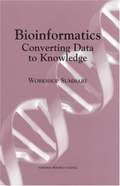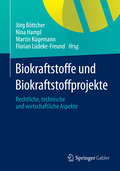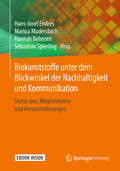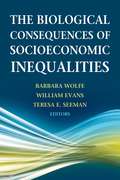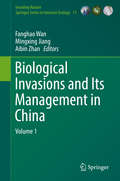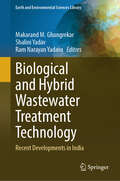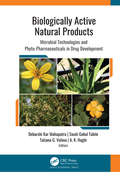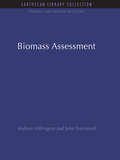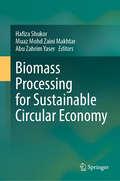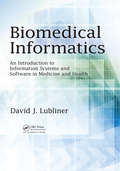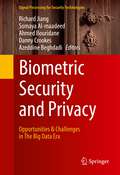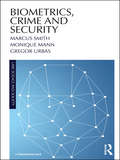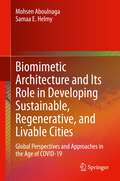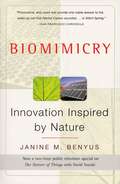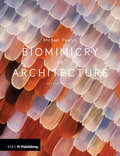- Table View
- List View
Bioinspired Strategic Design: Nature-Inspired Principles for Dynamic Business Environments
by Daniel J. Finkenstadt Tojin T. EapenOrganizations are commonly thrust into hostile operating environments where they are required to make strategic decisions that involve significant and costly tradeoffs. Such hostile environments may be endemic such as an economic recession or idiosyncratic such as a predatory action by an adversary. Many features of such hostile environments parallel those of living organisms that also demonstrate fine-tuned strategies to improve their survivability under adverse conditions. How can organizations use these “bioinspired strategies” to survive, and even potentially innovate? This book shows that the same three capabilities essential for the survival of living organisms in harsh environments – efficiency, resilience, and prominence – are also critical for organizations in their process of navigating through their own hostile environments. Throughout the book, the authors provide organizational executives with a systematic framework for thinking about strategic decision-making in a hostile environment leaning on analysis of real-world cases to draw out ontologies and methods for guiding their teams through disruptions, change management, innovation, and process improvements. In the first part, organizations are provided with a systematic approach to analyzing three survivability influences – forces, resources, and observers and their interrelationships. While all three influences are active across all organisms (and organizations), the exact nature of their interrelationship and the significance of each influence are unique to every organism (or organization). The framework helps organizations nail down the specific features of their operating environment that can help or hinder survivability by analyzing the three influences. Organizations can respond to external influences by developing three-pronged capabilities – efficiency, resilience, and prominence (ERP) – that respond to the three survivability influences. Organizations often struggle with identifying the appropriate strategies to apply under different conditions. Fortunately, nature provides several mechanisms that can be analogically applied to guide business strategies. The book contains many illustrations and examples of strategic principles observed among living organisms that can help an organization develop ERP capability. Finally, the book introduces seven strategic design heuristics – Combination, Elimination, Separation, Segmentation, Replication, Dynamics, and Maximization – observed in a living system that can be flexibly utilized to generate ideas to achieve strategic ends.
Biokraftstoffe und Biokraftstoffprojekte: Rechtliche, technische und wirtschaftliche Aspekte
by Jörg Böttcher Nina Hampl Martin Kügemann Florian Lüdeke-FreundDieses Buch beschäftigt sich mit Biokraftstoffen und Biokraftstoffprojekten. Die Autoren zeigen auf, welche rechtlichen, agrarischen, ökologischen und ökonomischen Rahmenbedingungen von Biokraftstoffen beachtet werden müssen. Die Betrachtung dieser Rahmenbedingungen und weiterer - eher anlagenbezogener - Faktoren ermöglicht es dann, Rückschlüsse auf die Realisierung von Biokraftstoffvorhaben zu ziehen. Besonderes Augenmerk wird dabei auf den sensiblen Themenkomplex der Nachhaltigkeit von Biokraftstoffen gerichtet. Die anhaltende Diskussion unerwünschter sozialer, ökologischer und ökonomischer Effekte hat zu neuen und bislang nicht abschließend definierten gesellschaftlichen und politischen Ansprüchen an die Biokraftstoffindustrie geführt.
Biokunststoffe unter dem Blickwinkel der Nachhaltigkeit und Kommunikation: Status quo, Möglichkeiten und Herausforderungen
by Hans-Josef Endres Marina Mudersbach Hannah Behnsen Sebastian SpierlingDas Buch zeigt, wie eine Nachhaltigkeitsbewertung von Biokunststoffen gelingen kann und wie die Ergebnisse einer solchen Bewertung ausfallen. Es analysiert die öffentliche Wahrnehmung beim Verbraucher sowie die politischen Rahmenbedingungen von Biokunststoffen.
Biolaw, Economics and Sustainable Governance: Addressing the Challenges of a Post-Pandemic World (Finance, Governance and Sustainability)
by Erick Valdés Jacob Dahl RendtorffThis book offers an accurate and updated approach to the main contributions of cosmopolitan biolaw in relation to sustainability, global governance, organizational health care economics and COVID-19. Bringing together different robust and dense biojuridical epistemologies to analyze key bioethical problems as well as the health care, management, economics and sustainability issues of our time, it constitutes a paradigmatic text in its field. In addition to exploring different epistemologies and jurisdictional scopes of biolaw, including the relationships between this new field and the challenges which have arisen in the current globalized and technologized world, the book addresses controversial issues straight from today’s headlines: for example, the basics for health care, finance and organizational economics, global biojuridical principles for governance, globalization, bioscientific empowerment, global and existential risk and sustainability challenges for a post-pandemic world. The book encourages readers to think impartially in order to know and understand the bioethical and biojuridical dilemmas that stem from current economics and sustainability issues. Accordingly, it will be a valuable resource for courses in the fields of biolaw, law, bioethics, global sustainability, organizational health care economics, and global governance at different professional levels.
Biological Consequences of Socioeconomic Inequalities, The
by Barbara Wolfe Teresa E. Seeman William EvansSocial scientists have repeatedly uncovered a disturbing feature of economic inequality: people with larger incomes and better education tend to lead longer, healthier lives. This pattern holds across all ages and for virtually all measures of health, apparently indicating a biological dimension of inequality. But scholars have only begun to understand the complex mechanisms that drive this disparity. How exactly do financial well-being and human physiology interact? The Biological Consequences of Socioeconomic Inequalities incorporates insights from the social and biological sciences to quantify the biology of disadvantage and to assess how poverty gets under the skin to impact health. Drawing from unusually rich datasets of biomarkers, brain scans, and socioeconomic measures, Biological Consequences of Socioeconomic Inequalities illustrates exciting new paths to understanding social inequalities in health. Barbara Wolfe, William N. Evans and Nancy Adler begin the volume with a critical evaluation of the literature on income and health, providing a lucid review of the difficulties of establishing clear causal pathways between the two variables. In their chapter, Arun S. Karlamangla, Tara L. Gruenewald, and Teresa E. Seeman outline the potential of biomarkers—such as cholesterol, heart pressure, and C-reactive protein—to assess and indicate the factors underlying health. Edith Chen, Hannah M. C. Schreier, and Meanne Chan reveal the empirical power of biomarkers by examining asthma, a condition steeply correlated with socioeconomic status. Their analysis shows how stress at the individual, family, and neighborhood levels can increase the incidence of asthma. The volume then turns to cognitive neuroscience, using biomarkers in a new way to examine the impact of poverty on brain development. Jamie Hanson, Nicole Hair, Amitabh Chandra, Ed Moss, Jay Bhattacharya, Seth D. Pollack, and Barbara Wolfe use a longitudinal Magnetic Resonance Imaging (MRI) study of children between the ages of four and eighteen to study the link between poverty and limited cognition among children. Michelle C. Carlson, Christopher L. Seplaki, and Teresa E. Seeman also focus on brain development to examine the role of socioeconomic status in cognitive decline among older adults. Featuring insights from the biological and social sciences, Biological Consequences of Socioeconomic Inequalities will be an essential resource for scholars interested in socioeconomic disparities and the biological imprint that material deprivation leaves on the human body.
Biological Extinction: New Perspectives
by Partha Dasgupta Peter H. Raven Anna L. McIvorThe rapidly increasing human pressure on the biosphere is pushing biodiversity into the sixth mass extinction event in the history of life on Earth. The organisms being exterminated are integral working parts of our planet's life support system, and their loss is permanent. Like climate change, this irreversible loss has potentially devastating consequences for humanity. As we come to recognise the many ways in which we depend on nature, this can pave the way for a new ethic that acknowledges the importance of co-existence between humans and other species. Biological Extinction features chapters contributed by leading thinkers in diverse fields of knowledge and practice, including biology, economics, geology, archaeology, demography, architecture and intermediate technology. Drawing on examples from various socio-ecological systems, the book offers new perspectives on the urgent issue of biological extinction, proposing novel solutions to the problems that we face.
Biological Invasions and Its Management in China: Volume 1 (Invading Nature - Springer Series in Invasion Ecology #11)
by Fanghao Wan Mingxing Jiang Aibin ZhanThe book discusses invasive-species problems in agriculture, forests and aquatic ecosystems, highlighting the invasive mechanisms and management of the selected invasive species. Biological invasion has become a serious global ecological and economic problem that deserves particular attention from both government officials and scientists. This volume focuses on three key scientific areas: 1) population establishment and spreading mechanisms of the selected invasive species; 2) ecology adaptation, population growth, expansion and evolution of invasive species; and 3) impact of bio-invasion on the ecosystem structure and function at community and ecosystem levels. The presented research will result in techniques for better management of invasive species. Dr. Fanghao Wan is a professor at the Chinese Academy of Agricultural Sciences Institute of Plant Protection in Beijing, China. Dr. Mingxing Jiang is a professor at Zhejiang University's College of Agriculture and Biotechnology Institute of Insect Sciences in Hangzhou, China. Dr. Aibin Zhan is a researcher at the Center for Eco-Environmental Sciences (RCEES) at the Chinese Academy of Sciences (CAS), Beijing, China.
Biological Invasions and Its Management in China: Volume 2 (Invading Nature - Springer Series in Invasion Ecology #13)
by Fanghao Wan Mingxing Jiang Aibin ZhanThe book discusses invasive-species problems in agriculture, forests and aquatic ecosystems, highlighting the invasive mechanisms and management of the selected invasive species. Biological invasion has become a serious global ecological and economic problem that deserves particular attention from both government officials and scientists. This volume focuses on three key scientific areas: 1) population establishment and spreading mechanisms of the selected invasive species; 2) ecology adaptation, population growth, expansion and evolution of invasive species; and 3) impact of bio-invasion on the ecosystem structure and function at community and ecosystem levels. The presented research will result in techniques for better management of invasive species. Dr. Fanghao Wan is a professor at the Chinese Academy of Agricultural Sciences Institute of Plant Protection in Beijing, China. Dr. Mingxing Jiang is a professor at Zhejiang University's College of Agriculture and Biotechnology Institute of Insect Sciences in Hangzhou, China. Dr. Aibin Zhan is a researcher at the Center for Eco-Environmental Sciences (RCEES) at the Chinese Academy of Sciences (CAS), Beijing, China.
Biological and Hybrid Wastewater Treatment Technology: Recent Developments in India (Earth and Environmental Sciences Library)
by Shalini Yadav Ram Narayan Yadava Makarand M. GhangrekarThis book provides technical information on different biological and hybrid wastewater treatment systems for the treatment of wastewater and reuse, and tracks their progress towards practical and field-scale applications including strategies to be adopted for minimizing the losses and maximizing the benefits, as well as protecting the environment through the application of advanced biological and hybrid wastewater treatment Technology. In addition, it discusses the crucial parts that science, technology, and innovation play in the formulation, implementation, and administration of wastewater treatment policy. It highlights the challenges that must be overcome to adopt biological and hybrid wastewater treatment infrastructure regulations successfully and provides some answers. Also, it investigates how the biological and hybrid wastewater treatment technology may be used in a wide variety of field's sets apart from other on-the-shelf publications on the market. Also, it delves into the core concepts of Biological and Hybrid Wastewater Treatment Systems. It explores how these concepts can be modified to fit a variety of contexts and uses. Applications such as managing facilities, dealing with pandemics, urban wastewater treatment and reuse, farming, and other applications are included in this book. As a consequence, this book's content is engaging, and it will pique the interest of a diverse audience of readers who come from a wide variety of different professional backgrounds. Therefore, the book is written by local experts in the topic who dealing with the treatment of wastewater treatment technologies for a long time in India. This book will be helpful to researchers, entrepreneurs, professionals, planners, policymakers, environmental engineers, and others interested in biological and hybrid wastewater treatment system management strategies through the application of breakthroughs in biological and hybrid wastewater treatment technologies.
Biologically Active Natural Products: Microbial Technologies and Phyto-Pharmaceuticals in Drug Development
by Debarshi Kar Mahapatra; Swati Gokul Talele; Tatiana G. Volova; A. K. HaghiBiologically active natural products and their substructures have long been valuable starting points for medicinal chemistry and drug discovery. This new volume explores biologically active natural products and their use in microbial technologies and as phyto-pharmaceuticals in drug development. It presents detailed scientific principles and recent research on applications of nanotechnology in diagnostics and drug delivery. Topics include pharmacotherapeutically active proteins and peptides; the biotechnological potential of hydrogen-oxidizing bacteria; synthesis and production; synthetic colorants, pigments, dyes, and lakes; and more. The use of various plants is discussed in several chapters, including Artemisia, Asteraceae, Abutilon indicum, Prosopis juliflora, Acacia arabica, Aloe barbadensis, Tabermontana divaricate Linn., among others. With the information presented in Biologically Active Natural Products: Microbial Technologies and Phyto-Pharmaceuticals in Drug Development, scientists, faculty, and graduate students will gain a unique insight into nanotechnology and natural pharmaceuticals today with practical implementation in various industrial sectors.
Biomass Assessment: Biomass Assessment (Energy and Infrastructure Set)
by John Townsend Andrew MillingtonEnergy is an issue for everyone and nowhere more so than in the SADCC countries. But for sensible policy and planning, clear information about the extent of resources is needed. This innovative study combines the results of field assessment of biomass with advanced techniques in remote sensing by satellite to give the first comprehensive and detailed picture of biomass distribution throughout the SADCC region. The authors describe their techniques, classify the kinds of biomass and give its distribution, by that classification, in all nine SADCC countries. Woody biomass resources and supplies are clearly analysed. This book is essential reading for project officers, planners and all others involved in the collection and analysis of data on biomass resources throughout the world. Originally published in 1988
Biomass Conversion and Sustainable Biorefinery: Towards Circular Bioeconomy (Green Energy and Technology)
by Seng Hua Lee Petar Antov Ľuboš Krišťák Muhammad Adly Rahandi Lubis Efri Mardawati Souvia Rahimah Robi Andoyo Bambang NurhadiThis book highlights recent progress on the advancements toward optimization of major biorefinery processes, including biomass pretreatment and fractionation, saccharification of sugars, and conversion of sugars and lignin into fuels and chemical precursors. The continual improvement of these processes and their integration in the format of a modern biorefinery is paving the way for a sustainable bio-economy that will displace large portions of petroleum-derived fuels and chemicals with renewable substitutes. Written by leading researchers from academia and well-renowned industry professionals, this book provides a comprehensive review of various aspects related to the recent developments in biomass conversion and biorefinery, aimed at successfully implementing the circular economy principles in various industries.
Biomass Processing for Sustainable Circular Economy
by Abu Zahrim Yaser Hafiza Shukor Muaz Mohd Zaini MakhtarThis book explores the pivotal role of biomass processing in catalyzing a sustainable circular economy, highlighting its ability to convert waste into useful materials. It offers a wide spectrum of topics, from Malaysia's biomass use to bioenergy supply chains and cutting-edge extraction technologies for bioactive compounds. Key bioconversion strategies like enzyme and single-cell protein production via biorefineries and green biosynthesis of solvents and chemicals are explored in detail. The book describes innovative low-cost biomimetic technologies using Black Soldier Fly and Compost Worms, bioelectrochemical systems fueled by biomass, and the use of biomass in food technology. The book further describes activated carbon production from wastewater treatment, hydrocarbons in high liquids using co-pyrolysis, and vegetable oils as renewable raw materials for polyurethane biobased foam. The primary themes include sustainability, engineering, and economic sustainability, with explorations of the latest trends and innovations in the processing of biomass. The use of biomass in circular economy principles, its transformation into renewable sources of energy, and its incorporation in various sectors are also explained. Through new technologies and eco-friendly strategies, this book is a necessity for researchers, business professionals, and policymakers committed to the innovation of biomass-based solutions.
Biomedical Informatics: An Introduction to Information Systems and Software in Medicine and Health
by David J. LublinerThis complete medical informatics textbook begins by reviewing the IT aspects of informatics, including systems architecture, electronic health records, interoperability, privacy and security, cloud computing, mobile healthcare, imaging, capturing data, and design issues. Next, it provides case studies that illustrate the roll out of EHRs in hospitals. The third section incorporates four anatomy and physiology lectures that focus on the physiological basis behind data captured in EHR medical records. The book includes links to documents and standards sources so students can explore each idea discussed in more detail.
Biometric Security and Privacy: Opportunities & Challenges in The Big Data Era (Signal Processing for Security Technologies)
by Ahmed Bouridane Richard Jiang Somaya Al-Maadeed Danny Crookes Azeddine BeghdadiThis book highlights recent research advances on biometrics using new methods such as deep learning, nonlinear graph embedding, fuzzy approaches, and ensemble learning. Included are special biometric technologies related to privacy and security issues, such as cancellable biometrics and soft biometrics. The book also focuses on several emerging topics such as big data issues, internet of things, medical biometrics, healthcare, and robot-human interactions. The authors show how these new applications have triggered a number of new biometric approaches. They show, as an example, how fuzzy extractor has become a useful tool for key generation in biometric banking, and vein/heart rates from medical records can also be used to identify patients. The contributors cover the topics, their methods, and their applications in depth.
Biometric and Intelligent Decision Making Support (Intelligent Systems Reference Library #81)
by Arturas KaklauskasThis book presents different methods for analyzing the body language (movement, position, use of personal space, silences, pauses and tone, the eyes, pupil dilation or constriction, smiles, body temperature and the like) for better understanding people's needs and actions, including biometric data gathering and reading. Different studies described in this book indicate that sufficiently much data, information and knowledge can be gained by utilizing biometric technologies. This is the first, wide-ranging book that is devoted completely to the area of intelligent decision support systems, biometrics technologies and their integrations. This book is designated for scholars, practitioners and doctoral and master's degree students in various areas and those who are interested in the latest biometric and intelligent decision making support problems and means for their resolutions, biometric and intelligent decision making support systems and the theory and practice of their integration and the opportunities for the practical use of biometric and intelligent decision making support.
Biometrics, Crime and Security (Law, Science and Society)
by Marcus Smith Monique Mann Gregor UrbasThis book addresses the use of biometrics – including fingerprint identification, DNA identification and facial recognition – in the criminal justice system: balancing the need to ensure society is protected from harms, such as crime and terrorism, while also preserving individual rights. It offers a comprehensive discussion of biometric identification that includes a consideration of: basic scientific principles, their historical development, the perspectives of political philosophy, critical security and surveillance studies; but especially the relevant law, policy and regulatory issues. Developments in key jurisdictions where the technology has been implemented, including the United Kingdom, United States, Europe and Australia, are examined. This includes case studies relating to the implementation of new technology, policy, legislation, court judgements, and where available, empirical evaluations of the use of biometrics in criminal justice systems. Examples from non-western areas of the world are also considered. Accessibly written, this book will be of interest to undergraduate, postgraduate and research students, academic researchers, as well as professionals in government, security, legal and private sectors.
Biometrics: Challenges, Trends and Opportunities
by Elena Higueras-Castillo Francisco Liébana-Cabanillas Francisco Muñoz-Leiva Juan F. Prados-CastilloThe book provides a comprehensive overview of biometrics, including its theoretical foundations and practical applications, and offers valuable insights into its relevance and impact on various sectors of society. It provides readers with a comprehensive view of how biometrics can shape future solutions that are secure, user focused, and technologically advanced. The first part discusses the fundamentals and applications of biometric technology. The second part discusses the challenges and future of biometric technologies.
Biomimetic Architecture and Its Role in Developing Sustainable, Regenerative, and Livable Cities: Global Perspectives and Approaches in the Age of COVID-19
by Mohsen Aboulnaga Samaa E. HelmyThis book focuses on understanding biomimetic architecture and its role as a sustainable design tool. It presents the role of biomimicry in mitigation and adaptation to climate change and examines how biomimetic architecture can provide healthy solutions to limit the spread of COVID-19 in buildings and cities. Coverage includes global examples of biomimetic approaches and buildings, an evaluation of the performance of biomimicry applications in architecture to illustrate best practices, and an exploration of how nature can offer inspiration in building design to conserve resources and save energy use as well as curb carbon emissions – a reaffirmed goal of COP 26 and an outcome of Glasgow Climate Pact. Finally, the book presents guidelines to enhance urban areas and healthier spaces in buildings to meet COVID-19 social distance regulations and beyond.Examines global applications of biomimicry in architecture;Highlights the importance of biomimicry in driving livability in cities and buildings;Explores the role of biomimetic architecture in mitigating climate change.“The line of argument developed is highly relevant to the present, in addition to being original and pertinent to research on urban regeneration, especially in regard to the exploration of the use of biomimicry architecture in response to changing urban demands.” —Alessandra Battisti, Ph.D., Professor of Architecture, University of Rome La Sapienza-
Biomimicry
by Janine M. BenyusThis profound and accessible book details how science is studying nature's best ideas to solve our toughest 21st-century problems. If chaos theory transformed our view of the universe, biomimicry is transforming our life on Earth. Biomimicry is innovation inspired by nature - taking advantage of evolution's 3.8 billion years of R&D since the first bacteria. Biomimics study nature's best ideas: photosynthesis, brain power, and shells - and adapt them for human use. They are revolutionising how we invent, compute, heal ourselves, harness energy, repair the environment, and feed the world. Science writer and lecturer Janine Benyus names and explains this phenomenon. She takes us into the lab and out in the field with cutting-edge researchers as they stir vats of proteins to unleash their computing power; analyse how electrons zipping around a leaf cell convert sunlight into fuel in trillionths of a second; discover miracle drugs by watching what chimps eat when they're sick; study the hardy prairie as a model for low-maintenance agriculture; and more.
Biomimicry and Business: How Companies Are Using Nature's Strategies to Succeed
by Margo FarnsworthBiomimicry, the practice of observing then mimicking nature’s strategies to solve business challenges, offers a path to healthy profit while working in partnership, and even reciprocity, with the natural world. Other books have described biomimicry, its uses, and its benefits. This book shows readers how to create their own biomimetic or bioinspired solutions with clear benefits to the bottom line, the environment, and people. Fashioned through storytelling, this book blends snapshots of five successful companies – Nike, Interface, Inc., PAX Scientific, Sharklet Technologies, and Encycle – which decided to partner with nature by deploying biomimicry. The book details how they discovered the practices, introduced them to staff, engaged in the process, and measured outcomes. The book concludes with challenges for readers to determine their own next steps in business and offers practical and useful resources to get there. By revealing the stories of each professional’s journey with lessons they learned, then providing resources and issuing a challenge and pathway to do business better, this book serves as a tool for entrepreneurs, seasoned professionals, and students to emulate nature’s brilliance, apply it at work, and contribute to a healthier, more prosperous world.
Biomimicry in Architecture
by Michael PawlynWhen searching for genuinely sustainable building design and technology - designs that go beyond conventional sustainability to be truly restorative - we often find that nature got there first. Over 3.5 billion years of natural history have evolved innumerable examples of forms, systems, and processes that can be applied to modern green design. For architects, urban designers and product designers, this new edition of Biomimicry in Architecture looks to the natural world to achieve radical increases in resource efficiency. Packed with case studies predicting future trends, this edition also contains updated and expanded chapters on structures, materials, waste, water, thermal control and energy, as well as an all-new chapter on light. An amazing sourcebook of extraordinary design solutions, Biomimicry in Architecture is a must-read for anyone preparing for the challenges of building a sustainable and restorative future.
Bionische Unternehmensführung
by Rüdiger FoxDieses Buch zeigt, was die Prinzipien der Evolution mit Ameisen und dem Staat Bhutan gemeinsam haben. Mit dem „Gross Corporate Happiness“ Ansatz stellt es ein wissenschaftlich fundiertes und in der Praxis erprobtes Führungsmodell vor und erhebt den Mitarbeiter vom Kostenfaktor zum wirtschaftlich wichtigsten Treiber für nachhaltigen Unternehmenserfolg in der Wissensgesellschaft. Das Werk liefert Antworten auf die brennendsten Fragen der Unternehmensführung im Kontext von Globalisierung und Digitalisierung: Wie motiviere ich meine Mitarbeiter richtig? Wie steigere ich die Innovationsleistung meines Unternehmens? Wie schaffe ich eine Kultur von Kooperation, Agilität und Resilienz in Zeiten beständigen Wandels? Dr. Rüdiger Fox erläutert wie intrinsische Motivation im Wirtschaftskontext zum Business Case wird und schlüsselt dafür die organisationsinternen Rahmenbedingungen auf, die neben der Zufriedenheit und dem „Flow“, die Innovations- und Kooperationsfähigkeit der Mitarbeiter steigern. Aus seiner praktischen Führungserfahrung schöpfend, zeigt der Autor, wie Organisationen in komplexen und dynamischen Märkten damit deutlich effizienter werden.
Biopatent Law: Patent Strategies And Patent Management (SpringerBriefs in Biotech Patents)
by Ulrich Storz Andreas Hübel Thilo SchmelcherPatents protecting biotechnological invention are becoming ever more important. Because biotechnology has many differences with respect to other technologies, lessons learned in other fields of technology cannot simply be transferred to adopt a suitable strategy for dealing with biotechnology inventions. In this volume, general aspects of biopatent law will be discussed. This involves questions of patentability, including ethical issues and issues of technicality, as well as questions of patent exhaustion in cases were reproducible subject matter, like cells or seeds, is protected. Moreover, active and passive patent strategies are addressed. Further, insight will be given into patent lifetime management and additional protective measures, like supplementary protection certificates and data exclusivity. Here, strategies are discussed how market exclusivity can be extended as long as possible, which is particularly important for biopharmaceutical drugs, which create high R&D costs.
